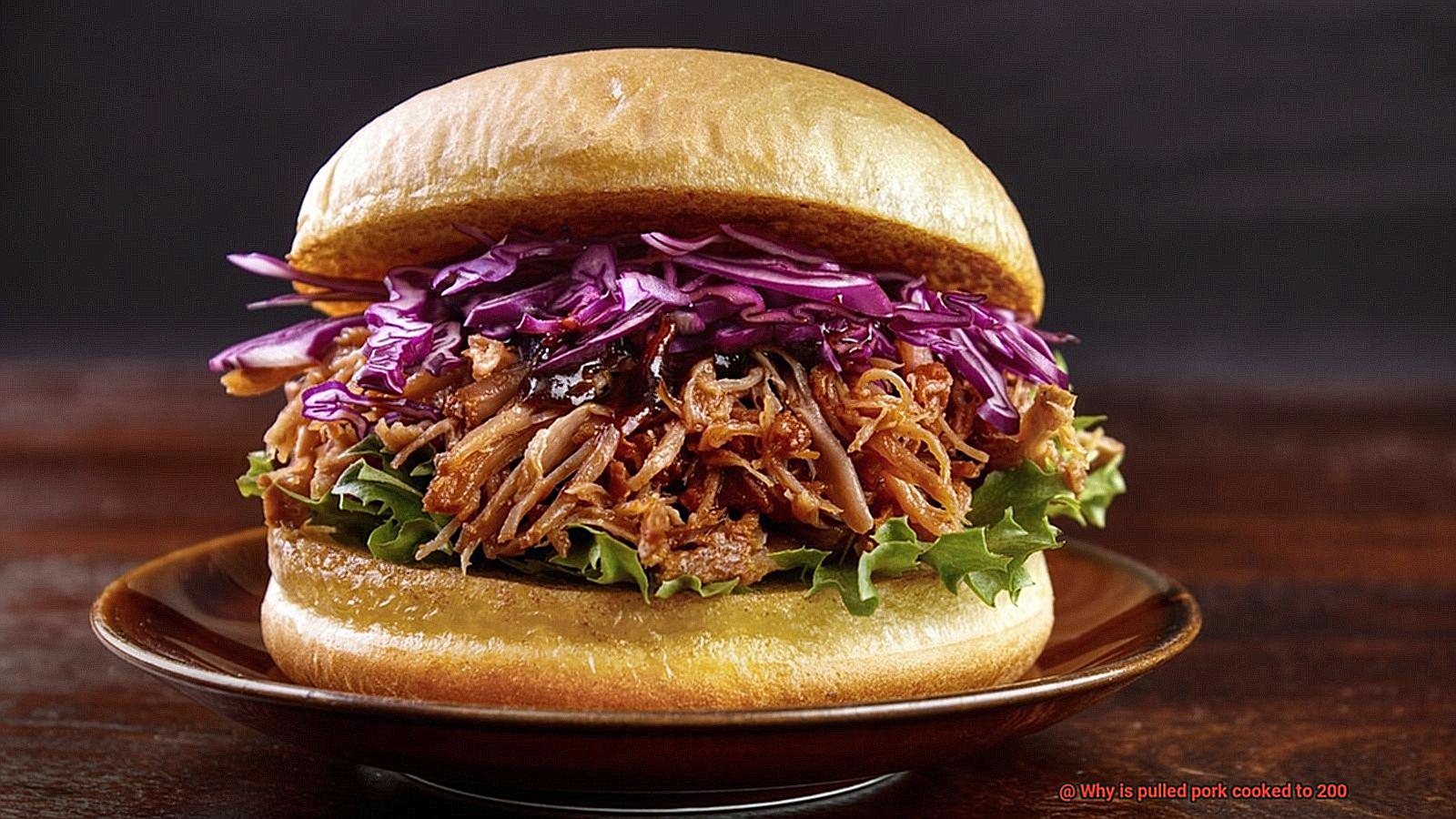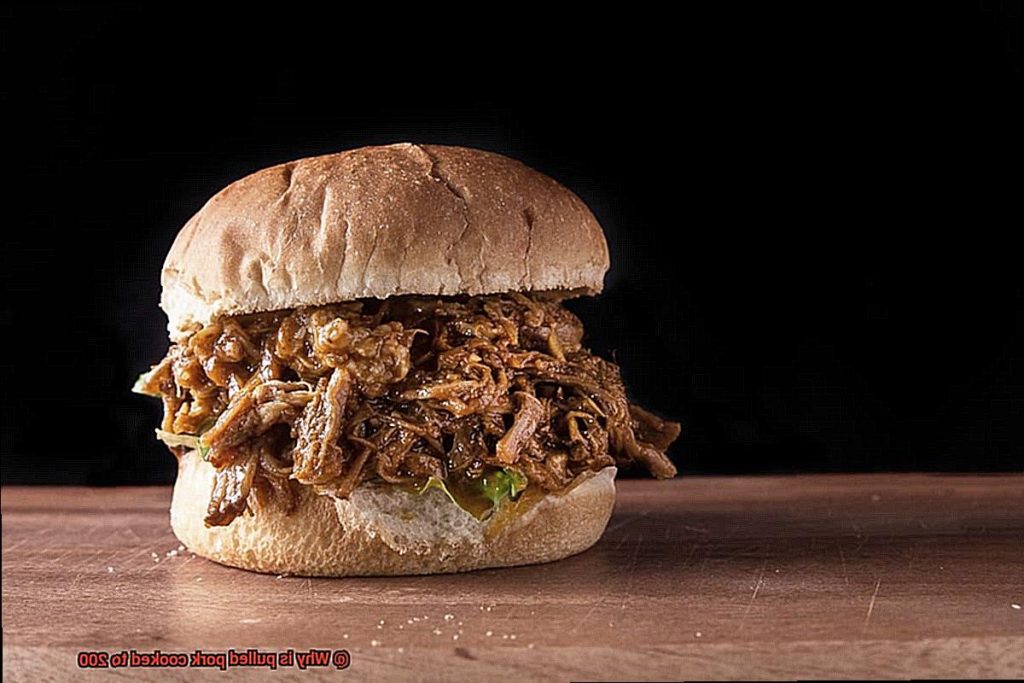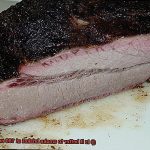Imagine a warm summer evening, the scent of savory meat wafting through the air. The sound of laughter and clinking glasses fills the backyard, and your mouth starts to water in anticipation. In the center of the table is a platter of tender, juicy pulled pork, cooked to perfection at 200 degrees Fahrenheit.
But why is this specific temperature so crucial? It’s not arbitrary – there’s actually science behind it. Pulled pork is slow-cooked until it’s so tender that it can be easily shredded apart. This process has everything to do with the unique properties of pork muscles and collagen.
Pork contains connective tissues made up of collagen, which begins breaking down around 160-170 degrees Fahrenheit. However, this breakdown takes time, and a specific temperature range must be maintained to achieve optimal tenderness. Cooking pulled pork to 200 degrees results in complete collagen breakdown, resulting in a velvety texture that melts in your mouth.
Pulled pork is an iconic dish loved by many across America. Its delicious taste comes from the perfect balance between science and artistry in cooking. So next time you indulge in a scrumptious pulled pork sandwich, remember that there’s more to it than just good seasoning – there’s also some serious science involved.
Contents
The Science Behind Cooking Pulled Pork
The answer lies in the science of collagen and slow cooking.
Collagen is a protein found in the connective tissue of meats, making them tough and fibrous. However, when exposed to heat, collagen begins to break down and convert into gelatin, which is much softer and more tender. This process is crucial in achieving the desired texture of pulled pork.
To start, it’s important to cook pork at a low temperature for several hours. The slow cooking process allows enough time for the collagen to break down into gelatin. The process begins at around 160-170 degrees Fahrenheit, but the magic really happens at 200 degrees Fahrenheit. At this temperature, almost all of the collagen has been converted into gelatin, resulting in a tender and juicy final product.
But what about keeping the meat from becoming dry and tough? The slow cooking also allows time for the fat in the meat to render out, creating a succulent and juicy texture. This ensures that every bite of pulled pork is packed with flavor.
It’s important to note that cooking pulled pork to an internal temperature of 200 degrees Fahrenheit does not mean sacrificing moisture or flavor. The collagen breakdown and rendering of fat results in a juicy and flavorful final product.
Why is the Ideal Temperature for Pulled Pork 200 Degrees Fahrenheit?
It all comes down to a specific temperature: 200 degrees Fahrenheit. But why is this temperature so crucial for achieving that mouth-watering, melt-in-your-mouth texture? The answer lies in the science of meat and collagen breakdown.
Pork shoulder, the cut of meat used for pulled pork, contains a lot of connective tissue called collagen. This collagen is what gives the meat its tough texture, but when cooked low and slow, it breaks down into gelatin, resulting in that juicy, tender texture we all crave.
Now, you might be wondering why we need to reach 200 degrees Fahrenheit specifically. While collagen starts breaking down at around 160-170 degrees Fahrenheit, it’s not until it reaches 190-200 degrees that enough collagen has broken down to create that perfect texture we all love in pulled pork. It’s science at work.
But it’s not just about taste. Cooking pork to this temperature also ensures that any harmful bacteria present in the meat have been destroyed, making it safe to eat.
So how do you achieve this ideal temperature? It’s important to use a meat thermometer to check the internal temperature and make sure it has reached 200 degrees before removing it from the heat source. This might require a bit of patience, but trust us, it’s worth it for that perfect pulled pork.
How Does Cooking at 200 Degrees Fahrenheit Enhance the Flavor and Texture of Pulled Pork?
Look no further than cooking it at 200 degrees Fahrenheit. As an expert in all things pulled pork, I can tell you that this low and slow cooking technique is a crucial step in achieving that melt-in-your-mouth texture and mouth-watering flavor.
Let’s talk about the science behind it. Cooking pulled pork at 200 degrees Fahrenheit is a slow, low-temperature process that allows the connective tissues in the meat to break down gradually. This creates a tender and juicy end-product that will leave your taste buds singing. Additionally, cooking at this temperature allows the fat in the pork to render slowly, adding even more delicious flavor to your dish.
But what about the stall phase? Don’t let this throw you off – it’s actually an important part of the cooking process. During this time, the temperature of the meat plateaus for several hours, allowing moisture to be released from the meat. This keeps it moist and tender throughout the cooking process, resulting in a delicious end-product.
Now, let’s talk about why cooking at a higher temperature is not recommended. When cooked at high temperatures, the proteins in the meat denature and tighten up, squeezing out moisture and leaving you with tough and dry meat. Cooking at a lower temperature for a longer period of time allows the meat to retain its juices and become more tender.
Benefits of Slow Cooking Pulled Pork to 200 Degrees Fahrenheit
Look no further than slow cooking it to 200 degrees Fahrenheit. This tried and true method is favored by grill masters for a reason – it produces pork that is fully cooked, juicy, and tender. No more dry and tough meat.
But the benefits don’t stop there. Slow cooking pulled pork to 200 degrees Fahrenheit also allows for the fat and connective tissue to break down over an extended period of time. The result? A melt-in-your-mouth texture that will have you savoring every bite. Plus, the extended cooking time gives any rubs or marinades ample opportunity to fully penetrate the meat, resulting in a more flavorful end product.
And let’s talk about how easy it is to shred pulled pork that has been slow-cooked to 200 degrees Fahrenheit. The meat has reached a temperature where it falls apart with ease when pulled with a fork or tongs, making it perfect for sandwiches or as a main dish with sides.
Tips for Perfectly Cooked Pulled Pork Every Time
Pulled pork is a beloved dish that’s easy to make, but getting it just right requires some attention to detail. One crucial element of perfectly cooked pulled pork is reaching an internal temperature of 200 degrees Fahrenheit. But why is this temperature so important?
To start, cooking the pork to 200 degrees Fahrenheit breaks down the connective tissue in the meat and makes it tender. Collagen is the protein responsible for meat’s structure, and it starts to break down at around 160-170 degrees Fahrenheit. However, it takes time for collagen to fully break down and become gelatin, which gives pulled pork its signature melt-in-your-mouth texture. By cooking the pork to 200 degrees Fahrenheit, you ensure that all the collagen has broken down and that your final product will be tender and juicy.
The 200-degree mark also plays a role in rendering out excess fat. As the pork cooks, fat begins to melt and lubricate the meat fibers. However, if the pork isn’t cooked to a high enough temperature, some of that fat remains intact and can result in a greasy or oily dish. Cooking the pork to 200 degrees Fahrenheit ensures that all excess fat has rendered out, leading to a flavorful and moist pulled pork.
However, hitting 200 degrees Fahrenheit alone isn’t enough for perfectly cooked pulled pork. It’s also important to cook the meat slowly and at a low temperature, allowing for even distribution of heat and preventing overcooking or drying out the meat. Once the pork has reached 200 degrees Fahrenheit, letting it rest for at least 20 minutes before shredding it allows the juices to redistribute throughout the meat, resulting in a more flavorful and moist final product.
Common Mistakes to Avoid When Cooking Pulled Pork

There are some common mistakes that can easily derail your efforts to create the perfect pulled pork. As an expert on the subject, I’m here to guide you through these pitfalls and help you achieve pulled pork perfection every time.
One of the most critical mistakes to avoid is rushing the cooking process. Pulled pork requires a low and slow cooking method, meaning it needs to be cooked for an extended period at a low temperature. Trying to speed up the process by cranking up the heat or cutting corners on the cooking time will result in tough and dry meat. Patience is key when it comes to cooking pulled pork.
Another mistake many novice cooks make is not properly seasoning their pork. While salt and pepper are great, they’re just the tip of the iceberg when it comes to enhancing the flavor of your pulled pork. A fantastic rub or marinade made with a blend of spices and seasonings will take your pulled pork from good to great.
Once your pork is cooked to perfection, don’t forget to let it rest before pulling it apart. Resting allows the juices to redistribute throughout the meat, resulting in a more tender and juicy final product. Skipping this step can lead to dry and tough pork that nobody wants to eat.
Finally, don’t overcomplicate things. Pulled pork is a simple dish that doesn’t require fancy techniques or equipment. Stick to the basics and let the natural flavors of the meat shine through.
How to Tell if Your Pulled Pork Is Cooked Through Properly
Pulled pork is a delicious and versatile dish, but it’s important to cook it properly to avoid any health risks. To ensure that you’re cooking your pulled pork to the right temperature, here are five tips to follow:
Tip #1: Use a Meat Thermometer
Using a meat thermometer is the most accurate way to check if your pulled pork is cooked through properly. Insert the thermometer into the thickest part of the meat, making sure not to touch any bones. If the temperature reads 200 degrees Fahrenheit, your pork is ready to come off the grill or smoker. This temperature is crucial as it ensures that all harmful bacteria have been killed off and that the meat is safe to eat.
Tip #2: Check for Tenderness
Another way to tell if your pulled pork is cooked through properly is by checking for tenderness. If the meat easily pulls apart with a fork or tongs, it’s likely done. If it still feels tough or resistant, it needs more time on the grill or smoker. It’s important to note that cooking times can vary depending on the size and thickness of your pork.
Tip #3: Look for Juices
When you cut into the meat, there should be clear juices running out of it. If the juices are still pink or red, the meat needs more cooking time. Clear juices mean that the meat has released all of its moisture and is fully cooked. This method is not as reliable as using a meat thermometer but can still provide some indication of doneness.
Tip #4: Check the Color
Pulled pork should be a dark brown color on the outside and slightly pink on the inside. If it’s still pink or red on the inside, it’s not fully cooked. Make sure to keep an eye on the color as you cook your pork to ensure that it’s fully cooked. Remember that visual cues such as color and texture can be misleading, so always use a meat thermometer to check for doneness.
Tip #5: Be Patient.
Cooking pulled pork to 200 degrees Fahrenheit takes time, but it’s worth it for the tender and juicy end result. Don’t rush the cooking process or try to cut corners – this can lead to undercooked and unsafe meat. A general rule of thumb is to allow for about 1-1.5 hours of cooking time per pound of meat. Factors like the type of grill or smoker, ambient temperature, and altitude can also affect cooking times, so be patient and monitor the internal temperature regularly.
Alternative Ways to Cook Delicious Pulled Pork
Here are five alternative methods for cooking delicious pulled pork that will take your taste buds on a thrilling ride.
Slow Cooking in a Crockpot or Slow Cooker
Slow cooking in a crockpot or slow cooker is one of the easiest ways to cook pulled pork. Season the pork shoulder with your favorite spices and place it in the crockpot with some liquid, such as apple cider vinegar or chicken broth. The low heat setting for 8-10 hours will make the pork fall-apart tender and juicy, ready to be shredded with a fork.
Pressure Cooking
If you’re short on time, pressure cooking is an excellent option. Sear the pork first to lock in flavor, then add liquid and pressure cook for 60-90 minutes depending on the size of the meat. The result is tender and flavorful pulled pork in a fraction of the time it takes to slow-cook.
Grilling
Grilling is another way to cook pulled pork that doesn’t require a smoker or oven. Sear the meat over high heat to create a crust, then move it to indirect heat and let it cook until it reaches an internal temperature of 200 degrees Fahrenheit. While grilling may not produce the same smoky flavor as a smoker, it can still yield delicious results.
Dutch Oven
Using a Dutch oven is another alternative method for cooking pulled pork that will leave you wanting more. Season the meat and sear it, then add liquid and cover with the lid. Cook it in the oven at 300 degrees Fahrenheit for 3-4 hours until it’s tender enough to shred with a fork. The result: moist and flavorful pulled pork that’s perfect for sandwiches or tacos.
Instant Pot
The Instant Pot is another great option for cooking pulled pork quickly and easily. Sear the meat first, then add liquid and pressure cook for 60-90 minutes depending on the size of the meat. The result is a juicy and tender pulled pork that’s ready to be shredded and devoured.
4-G7L0zIkjs” >
Conclusion
In conclusion, 200 degrees Fahrenheit is not just a number, but the key to achieving the perfect pulled pork. This temperature allows for the breakdown of collagen and rendering of fat that results in a tender and juicy final product that will make your taste buds dance with joy. Slow-cooking at a low temperature is essential to allow enough time for the connective tissue to break down gradually, resulting in a succulent end-product.
While there are alternative methods like slow cookers or pressure cookers, patience is crucial when it comes to achieving desired tenderness. Rushing the cooking process can lead to tough and dry meat. It’s also important to use a meat thermometer to ensure that the internal temperature has reached 200 degrees Fahrenheit before removing it from the heat source.
Avoid common mistakes like overcooking or under-seasoning your pork, and let your meat rest before shredding it apart. This allows juices to redistribute throughout the meat for maximum flavor.
Whether you’re grilling, smoking or slow-cooking your pulled pork, remember that cooking it to 200 degrees Fahrenheit is essential for achieving mouth-watering texture and flavor. There’s more science involved than just good seasoning.






